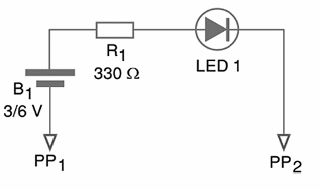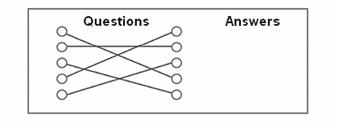This computer is like a toy due to its simplicity. It is an ‘intelligent machine’ that answers with a signal given by a LED when the correct answer is chosen, after being given a question. In a table there are questions and answers placed in a random away. The subject of these questions is chosen by the builder. You can have states and capitals, invents and inventors, colors and fruits, etc.
The principle of operation is the same found in computers, the digital logic. This principle makes it ideal for demonstrations in science fairs and Technology Education classes.
In a panel there are two rows, one with questions and the other with answers. But the answers are not in order. Associated to each question and answer there is a nail or contact that can be touched with probes. The probes are connected to an indicator circuit. Under the panel, there are wires interconnecting questions and the correspondent answers.
So when you touch the questions and the correspondent answer with the probes, you close the circuit, turning on the LED indicator. If you touch a question and the incorrect answer with the probes, the LED does not turn on. Figure 1 shows the circuit of the computer.


An interesting upgrade for this project is the creation of cards with holes that fit on the terminals. Each card can explore a certain subject as sciences, geography, history, inventions and inventors, name of animals and classification, and all the subjects studied in common courses during middle school and high school.
Any LED can be used and the resistor is a 1/8 W or higher dissipation type. For the panel contacts, you can use small nails, screws or other objects with a metal surface. The nails have the advantage of allowing the wires to be soldered directly to them. The probes PP1 and PP2 are made with larger nails.
Another solution is the use of common Multimeter probes. The panel is a wood piece measuring 30 x 40 cm. The size depends on the amount of questions you intend to ask.
Competition:
- Organize a questions & answers competition. The teacher can assemble a giant version of the computer placing it in the wall and using it in classes.
LED— Common red LED or other color
B1—3 V—2 cells with holder
R1—330 ? x 1/8 W—resistor—orange, orange, brown
PP1, PP2—Probes—see previous text
Other:
Terminal strip, wooden panel, nails or screws, wires, solder, etc.



